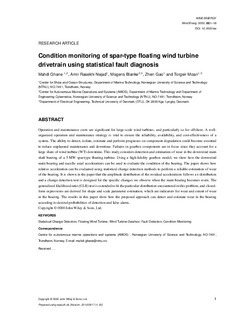Condition monitoring of spar‐type floating wind turbine drivetrain using statistical fault diagnosis
Journal article
Submitted version
Permanent lenke
http://hdl.handle.net/11250/2496733Utgivelsesdato
2018Metadata
Vis full innførselSamlinger
- Institutt for marin teknikk [3472]
- Institutt for teknisk kybernetikk [3787]
- Publikasjoner fra CRIStin - NTNU [38576]
Originalversjon
10.1002/we.2179Sammendrag
Operation and maintenance costs are significant for large‐scale wind turbines and particularly so for offshore. A well‐organized operation and maintenance strategy is vital to ensure the reliability, availability, and cost‐effectiveness of a system. The ability to detect, isolate, estimate, and perform prognoses on component degradation could become essential to reduce unplanned maintenance and downtime. Failures in gearbox components are in focus since they account for a large share of wind turbine downtime. This study considers detection and estimation of wear in the downwind main‐shaft bearing of a 5‐MW spar‐type floating turbine. Using a high‐fidelity gearbox model, we show how the downwind main bearing and nacelle axial accelerations can be used to evaluate the condition of the bearing. The paper shows how relative acceleration can be evaluated using statistical change‐detection methods to perform a reliable estimation of wear of the bearing. It is shown in the paper that the amplitude distribution of the residual accelerations follows a t‐distribution and a change‐detection test is designed for the specific changes we observe when the main bearing becomes worn. The generalized likelihood ratio test is extended to fit the particular distribution encountered in this problem, and closed‐form expressions are derived for shape and scale parameter estimation, which are indicators for wear and extent of wear in the bearing. The results in this paper show how the proposed approach can detect and estimate wear in the bearing according to desired probabilities of detection and false alarm.
